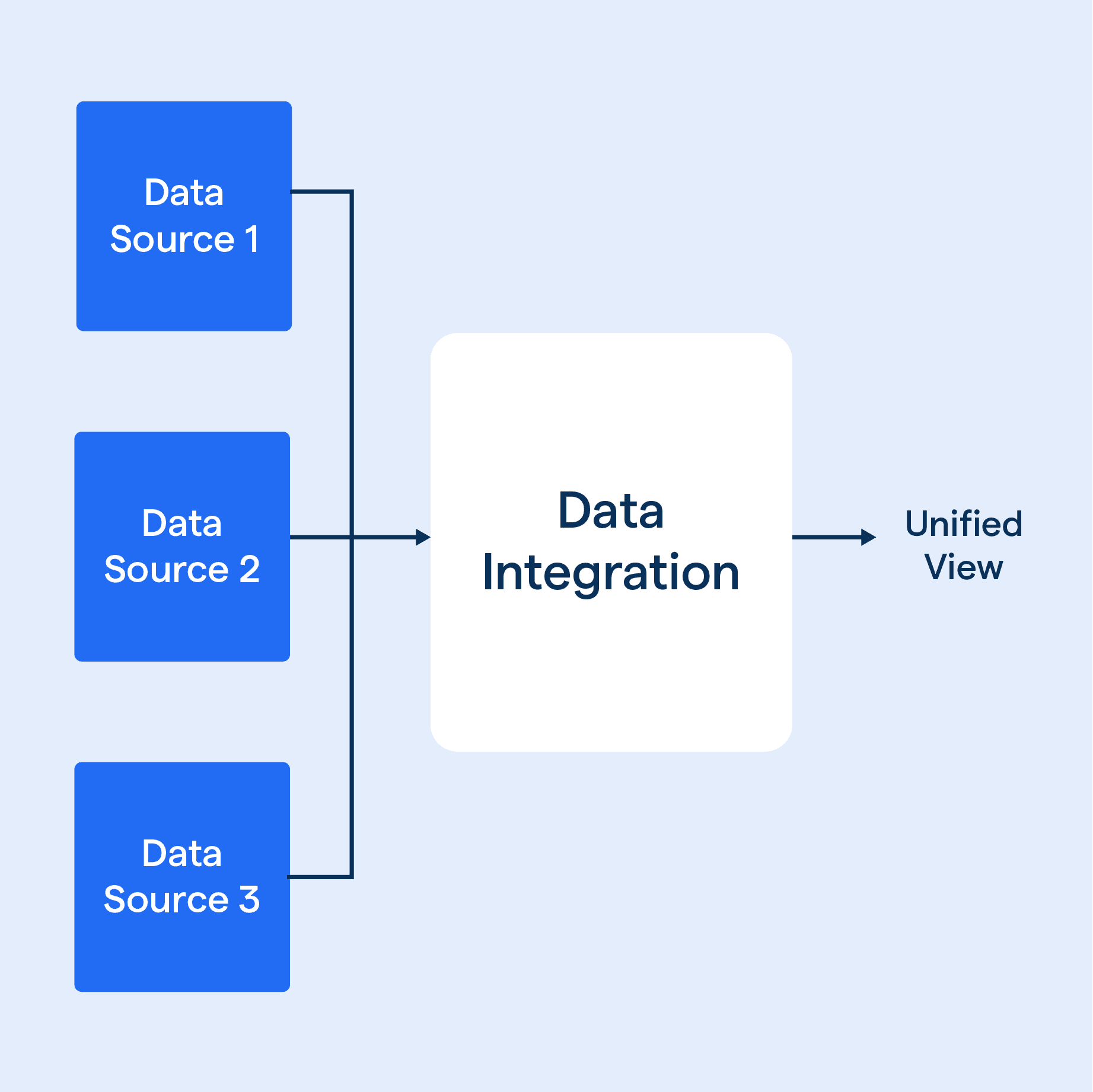What is Data Integration?
Data integration, my dear Watson, is the process of combining data from disparate sources into a unified, meaningful, and easily accessible format. It's like making a delicious smoothie by blending various fruits and ingredients together, so you get a tasty and nutritious concoction.
Importance of Data Integration
Imagine trying to make sense of a jigsaw puzzle with pieces from different boxes all jumbled up. That's what it's like when data is scattered across multiple systems. Data integration brings those pieces together, allowing businesses to make data-driven decisions, improve efficiency, and gain a competitive edge.
Key Components of Data Integration
The secret sauce of data integration consists of three main ingredients: data extraction, data transformation, and data loading. These components work together to ensure that data is properly collected, cleansed, and stored in a target system.
Why is Data Integration Necessary?
Streamlined Decision-Making
Data integration is necessary because it consolidates data from various sources, providing a unified view of information. This enables businesses to make informed decisions based on comprehensive and accurate data.
Enhanced Collaboration
Data integration allows team members from different departments to access and share information easily, fostering collaboration and improving overall productivity within an organization.
Improved Data Quality
By integrating data from multiple sources, data quality can be enhanced through the process of data validation, cleansing, and deduplication. This ensures that businesses rely on accurate and consistent data for their operations and decision-making.
Real-Time Insights

Data integration enables real-time access to critical information, allowing businesses to respond quickly to market trends, customer needs, and other time-sensitive factors, ultimately leading to increased competitiveness.
Simplified Data Management
Integrating data into a centralized system simplifies data management tasks, such as data backup, security, and compliance. This reduces the time and resources spent on managing multiple data sources, allowing businesses to focus on their core operations.
Types of Data Integration
Extract, Transform, Load (ETL)
ETL is the granddaddy of data integration techniques. It involves extracting data from multiple sources, transforming it into a consistent format, and loading it into a target system, like a data warehouse.
Enterprise Application Integration (EAI)
EAI is like a skilled matchmaker that connects different enterprise applications to facilitate seamless data exchange and streamline business processes.
Enterprise Information Integration (EII)
Enterprise Information Integration (EII) is the Sherlock Holmes of data integration. It allows businesses to access and analyze data from various sources in real-time without physically moving the data.
Data Federation
Data federation is like a virtual data room where data from multiple sources is consolidated and made available for querying and analysis.
Data Replication
Data replication is the process of creating and maintaining multiple copies of data across different systems to ensure data consistency and availability.
Data Virtualization
Data virtualization is like a magic mirror that provides a unified view of data from different sources without actually moving the data.
Data Integration Techniques
Data Warehousing
Data warehousing is like a giant storage room that holds large volumes of structured and semi-structured data from various sources, enabling businesses to perform in-depth analysis and reporting.
Data Lakes
Data lakes are like vast reservoirs that store raw, unprocessed data from different sources, allowing businesses to harness the power of big data and advanced analytics.
Data Marts
Data marts are like small, specialized stores that provide a focused view of specific business areas, making data analysis more efficient and targeted.
Data Hubs
Data hubs are like bustling town squares where data from multiple sources is consolidated, enabling businesses to access and share information more easily.
Data Integration Tools
Popular Data Integration Tools
There's a smorgasbord of data integration tools out there, each with its unique flavor. Some popular options include:
- Microsoft SQL Server Integration Services (SSIS)
- Informatica PowerCenter
- IBM InfoSphere DataStage
- Talend Data Integration
- Oracle Data Integrator (ODI)
Comparison of Data Integration Tools
When choosing a data integration tool, it's essential to compare features, ease of use, scalability, and cost. Think of it like a game of "Top Trumps" where you need to find the tool with the best combination of attributes that suit your needs.
Factors to Consider When Choosing a Data Integration Tool
Before you embark on your data integration tool quest, consider the following factors:
- Compatibility with existing systems
- Scalability and performance
- Ease of use and learning curve
- Support for various data types and formats
- Security and compliance features
Data Integration Best Practices
Establishing Data Governance
Data governance is like the wise old sage that guides your data integration journey. It involves defining policies, processes, and roles to ensure data accuracy, consistency, and security.
Ensuring Data Quality
Garbage in, garbage out, as they say. Ensuring data quality is crucial to the success of any data integration project. This includes data cleansing, validation, and deduplication.
Scalability and Performance Considerations
As your business grows, so does your data. It's essential to choose a data integration solution that can scale with your needs and deliver top-notch performance.
Security and Compliance
Data integration projects must adhere to various security and compliance standards to protect sensitive information and avoid costly fines.
Data Integration Use Cases
Business Intelligence and Analytics
Data integration plays a crucial role in enabling businesses to gather insights, identify trends, and make informed decisions through business intelligence and analytics tools.
Mergers and Acquisitions
When companies merge or acquire other businesses, data integration is essential for consolidating systems and ensuring a smooth transition.
Data Migration
Data migration projects, such as moving to a new system or upgrading existing infrastructure, often require data integration to ensure data consistency and accuracy.
Master Data Management
Data integration is a key component of master data management, helping businesses maintain a single, consistent view of critical data elements.
Suggested Reading:
Data fusion
How to Implement a Data Integration Strategy?
Assessing Your Data Integration Needs
Before diving into the world of data integration, it's essential to evaluate your current data landscape, identify gaps, and define your integration goals.
Planning and Designing Your Data Integration Solution
Once you've assessed your needs, it's time to plan and design your data integration solution, including selecting the right techniques, tools, and best practices.
Executing Your Data Integration Strategy
With a solid plan in place, it's time to roll up your sleeves and execute your data integration strategy, ensuring proper testing, monitoring, and validation along the way.
Monitoring and Maintaining Your Data Integration System
Data integration is not a one-time event. It's essential to continuously monitor and maintain your data integration system to ensure optimal performance and data quality.
Frequently Asked Questions

What is data integration?
Data integration is the process of combining data from multiple sources, creating a unified view for analysis, reporting, and decision-making.
Why is data integration important?
Data integration is important because it streamlines decision-making, improves data quality, enhances collaboration, provides real-time insights, and simplifies data management.
What are common data integration techniques?
Common techniques include ETL (Extract, Transform, Load), data warehousing, data virtualization, and data federation.
How does data integration affect data security?
Data integration can improve data security by centralizing data management, allowing for consistent security measures and easier monitoring of potential threats.
Can data integration be automated?
Yes, data integration can be automated using tools and software that streamline data extraction, transformation, and loading, reducing manual effort and improving efficiency.

